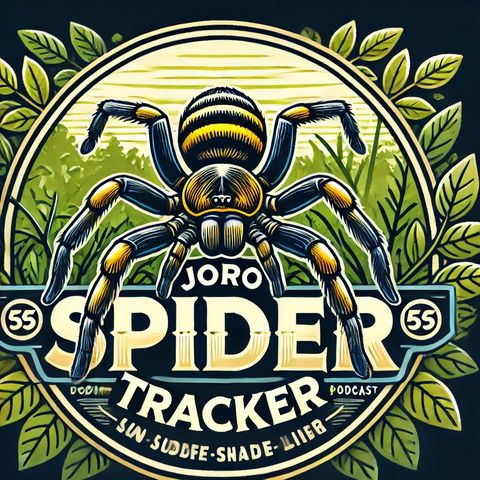Invasive Species Threaten Quebec's Ecosystems: Joro Spiders and Chinese Mystery Snails Raise Concerns
Aug 12, 2024 ·
3m 12s

Download and listen anywhere
Download your favorite episodes and enjoy them, wherever you are! Sign up or log in now to access offline listening.
Description
In Quebec, the invasion of non-native species is causing concern among ecologists and the general public alike. Among them, the Joro spider and the Chinese mystery snail stand out for...
show more
In Quebec, the invasion of non-native species is causing concern among ecologists and the general public alike. Among them, the Joro spider and the Chinese mystery snail stand out for their distinctive attributes and the unknown long-term effects they may pose to local ecosystems.
First spotted in North America around the 2010s, the Joro spider, native to East Asia, is particularly noted for its striking appearance. These spiders have a bright yellow, blue, and red coloration on their bodies, making them easily identifiable. These arachnids are also known for their impressive web-building skills, often creating large, durable webs that can span several feet across. Interestingly, despite their fearsome look and venom, Joro spiders are not a threat to humans. Their venom is not harmful to people, and they tend to be quite passive, avoiding human interaction whenever possible.
While there have been speculations and sensational claims about these spiders potentially spreading rapidly across regions, experts suggest that such scenarios are unlikely in the colder climate of Quebec due to the spider's preference for milder temperatures. Though they’re capable of traveling long distances by ballooning—using their webs as sails to catch the wind—this does not necessarily lead to immediate widespread distribution, particularly in less hospitable climates.
Another invasive species troubling local waters are the Chinese mystery snails. These snails, which originated from Southeast Asia, have been infiltrating Quebec’s lakes and ponds. Easily recognizable by their large size and unique olive to brownish-black shells, they have few natural predators in North America which allows their populations to grow rapidly and uncontrollably. The primary concern with these snails is their potential to outcompete native species for food and habitat, which could lead to declines in native biodiversity. Moreover, they are known carriers of parasites and diseases, which could affect both native wildlife and human populations indirectly.
These growing populations highlight the challenges of managing invasive species, which often include exhaustive eradication efforts, public education on prevention, and continuous monitoring of affected ecosystems. One key strategy in fighting the spread of these species is public awareness and the discouragement of their transport and release into wild habitats.
Finally, Quebec is also facing other potential threats from invasive species such as the lanternfly, a pest known to damage agricultural crops significantly. Native to China, this insect has been causing serious problems in the United States and is anticipated to make its way into Canada soon.
In conclusion, while the Joro spider poses less of an imminent threat to Quebec due to its climatic preferences, the broader issue of invasive species like the Chinese mystery snail and the lanternfly necessitates vigilant monitoring, quick action, and widespread public cooperation to protect local ecosystems and economies from significant disruption.
show less
First spotted in North America around the 2010s, the Joro spider, native to East Asia, is particularly noted for its striking appearance. These spiders have a bright yellow, blue, and red coloration on their bodies, making them easily identifiable. These arachnids are also known for their impressive web-building skills, often creating large, durable webs that can span several feet across. Interestingly, despite their fearsome look and venom, Joro spiders are not a threat to humans. Their venom is not harmful to people, and they tend to be quite passive, avoiding human interaction whenever possible.
While there have been speculations and sensational claims about these spiders potentially spreading rapidly across regions, experts suggest that such scenarios are unlikely in the colder climate of Quebec due to the spider's preference for milder temperatures. Though they’re capable of traveling long distances by ballooning—using their webs as sails to catch the wind—this does not necessarily lead to immediate widespread distribution, particularly in less hospitable climates.
Another invasive species troubling local waters are the Chinese mystery snails. These snails, which originated from Southeast Asia, have been infiltrating Quebec’s lakes and ponds. Easily recognizable by their large size and unique olive to brownish-black shells, they have few natural predators in North America which allows their populations to grow rapidly and uncontrollably. The primary concern with these snails is their potential to outcompete native species for food and habitat, which could lead to declines in native biodiversity. Moreover, they are known carriers of parasites and diseases, which could affect both native wildlife and human populations indirectly.
These growing populations highlight the challenges of managing invasive species, which often include exhaustive eradication efforts, public education on prevention, and continuous monitoring of affected ecosystems. One key strategy in fighting the spread of these species is public awareness and the discouragement of their transport and release into wild habitats.
Finally, Quebec is also facing other potential threats from invasive species such as the lanternfly, a pest known to damage agricultural crops significantly. Native to China, this insect has been causing serious problems in the United States and is anticipated to make its way into Canada soon.
In conclusion, while the Joro spider poses less of an imminent threat to Quebec due to its climatic preferences, the broader issue of invasive species like the Chinese mystery snail and the lanternfly necessitates vigilant monitoring, quick action, and widespread public cooperation to protect local ecosystems and economies from significant disruption.
Information
| Author | QP-4 |
| Organization | William Corbin |
| Website | - |
| Tags |
Copyright 2024 - Spreaker Inc. an iHeartMedia Company
